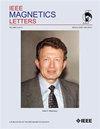钐钴厚膜中相间耦合的微观结构演变和一阶反转曲线分析
IF 1.1
4区 物理与天体物理
Q4 ENGINEERING, ELECTRICAL & ELECTRONIC
引用次数: 0
摘要
通过射频溅射法在硅衬底上沉积了 W/SmCo/W 结构的 500 nm 厚钐钴薄膜。在 650-750 °C 退火后,生长的软质无定形结构转变为结晶 Sm2Co17 和 SmCo5 硬磁相的混合物。在 650 °C 退火后,薄膜结晶,平均晶粒大小为 64 nm,矫顽力为 0.5 T,在最大外加磁场为 2 T 时,剩磁约为 0.5 T;在 750 °C 退火后,剩磁降低了 20%,而平均晶粒大小和矫顽力则分别增加到 73 nm 和 1.1 T。在 650 ℃ 和 750 ℃ 下退火的样品记录的一阶反转曲线系列表明,开关场在较软(Sm2Co17)和较硬(SmCo5)相之间重新分布,这取决于相间相互作用的强度。总之,在 650 ℃ 下退火的薄膜具有较高的剩磁和相当大的矫顽力,是制造集成到微机电系统中的微型磁体的理想材料。本文章由计算机程序翻译,如有差异,请以英文原文为准。
Microstructure Evolution and First-Order Reversal Curve Analysis of the Interphase Coupling in SmCo Thick Film
Thick SmCo films of 500 nm thickness were deposited by radio frequency sputtering in W/SmCo/W structures on a Si substrate. After annealing at 650–750 °C, the as-grown soft amorphous structure transforms into a mixture of crystalline Sm
2
Co
17
and SmCo
5
hard magnetic phases. Annealing at 650 °C leads to film crystallization with an average grain size of 64 nm, coercivity of 0.5 T, and remanence magnetization of about 0.5 T for a maximum applied field of 2 T. The remanence magnetization decreases by 20% upon annealing at 750 °C, whereas the average crystalline size and coercivity increase up to 73 nm and 1.1 T, respectively. Series of the first-order reversal curves recorded in the samples that were annealed at 650 °C and 750 °C demonstrate redistribution of the switching fields between the softer (Sm
2
Co
17)
and harder (SmCo
5
) phases, depending on the strength of interphase interaction. Overall, the higher remanence and sizable coercivity of films annealed at 650 °C make them good candidates for the fabrication of micromagnets to be integrated in microelectromechanical systems.
求助全文
通过发布文献求助,成功后即可免费获取论文全文。
去求助
来源期刊

IEEE Magnetics Letters
PHYSICS, APPLIED-
CiteScore
2.40
自引率
0.00%
发文量
37
期刊介绍:
IEEE Magnetics Letters is a peer-reviewed, archival journal covering the physics and engineering of magnetism, magnetic materials, applied magnetics, design and application of magnetic devices, bio-magnetics, magneto-electronics, and spin electronics. IEEE Magnetics Letters publishes short, scholarly articles of substantial current interest.
IEEE Magnetics Letters is a hybrid Open Access (OA) journal. For a fee, authors have the option making their articles freely available to all, including non-subscribers. OA articles are identified as Open Access.
 求助内容:
求助内容: 应助结果提醒方式:
应助结果提醒方式:


